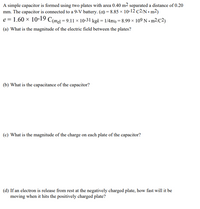Question
I am stuck on this problem from my physics class. Any assistance is appreciated!

Transcribed Image Text:A simple capacitor is formed using two plates with area 0.40 m2 separated a distance of 0.20
mm. The capacitor is connected to a 9-V battery. (ɛ0 = 8.85 × 10-12 C2/N • m²)
e = 1.60 × 10-19 C(mel = 9.11 × 10-31 kgk = 1/4r80 = 8.99 × 109 N • m²/C2)
(a) What is the magnitude of the electric field between the plates?
(b) What is the capacitance of the capacitor?
(c) What is the magnitude of the charge on each plate of the capacitor?
(d) If an electron is release from rest at the negatively charged plate, how fast will it be
moving when it hits the positively charged plate?
Expert Solution
This question has been solved!
Explore an expertly crafted, step-by-step solution for a thorough understanding of key concepts.
This is a popular solution
Trending nowThis is a popular solution!
Step by stepSolved in 3 steps

Knowledge Booster
Similar questions
- This is a physics homework question that I am having trouble with, any help would be great!arrow_forwardThe class I'm taking is physics for scientists and engineers! I am completely stuck. Need help. I have attached the problem. If you can please explain your answer so I can fully understand. Thank you!arrow_forwardHello, I was trying to solve just the first three. Thank you very much!arrow_forward
arrow_back_ios
SEE MORE QUESTIONS
arrow_forward_ios